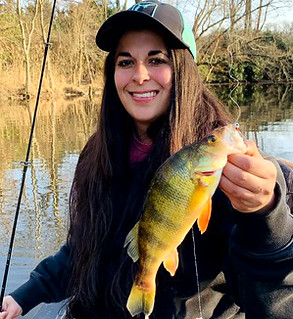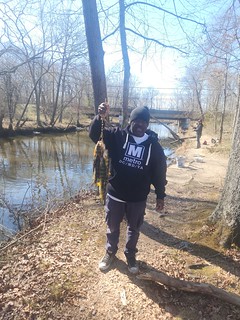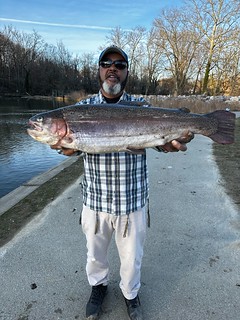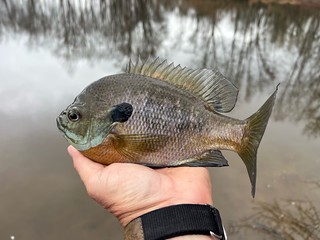Maryland Fishing Report – March 15

Angelina Watts holds up a beautiful yellow perch caught recently. Photo by Rich Watts
There is an old saying that March comes in like a lion, and truer words could not be spoken this past week. The forecast now calls for warmer and less windy weather, so anglers will be out enjoying good fishing for trout that was stocked in areas that are open. Yellow and white perch are providing plenty of exciting fishing action in the upper reaches of the spawning rivers this week.
Forecast Summary: March 15 – March 21:
Winter is in its final week and will not give up easily. However, as the days grow longer and increasingly warmer, Chesapeake Bay waters will also warm up for game fish such as yellow perch that are spawning or preparing to spawn. Main Bay surface water temperatures have risen to the mid 40s. River temperatures are holding in the low 40s. However, smaller streams and downwind areas on a sunny day will warm faster and often hold water temperatures in the upper 40s. These are prime locations for spawning yellow perch as they move up from their wintering areas in the downstream portion of rivers.
Expect average flows for most Maryland rivers and streams. Bay salinities are about normal. Expect average clarity for most Maryland portions of the Bay and rivers, except the Gunpowder River and Tolchester areas. To see the latest water clarity conditions, check Eyes on the Bay Satellite Maps. There will be above average tidal currents Saturday through Tuesday as a result of the upcoming new moon on March 22.
As always, the best fishing areas could be further refined by intersecting them with underwater points, hard bottom, drop-offs, and large schools of baitfish.
For more detailed and up-to-date fishing conditions in your area of the bay, be sure to check out Eyes on the Bay’s Click Before You Cast.
At the very top of the Bay, anglers are enjoying a yellow perch spawning run in the North East River near the mouth of the North East Creek. Anglers are also enjoying good fishing for yellow perch on the upper Bush and Magothy rivers as well as the Chester River near Millington. Small lip-hooked minnows on a small jig head, shad dart, or bottom rig are the most popular ways to catch them.
White perch will be arriving in many areas this week, especially on the western side of the Bay. The lower Susquehanna River will be one of the last places for them to arrive due to the cold water coming from the Conowingo Dam. Grass shrimp and pieces of bloodworm work well for white perch on small jigs and bottom rigs.
A mix of blue and channel catfish can be found in most of the region’s tidal rivers. They tend to be holding in the channels and can be caught on a variety of cut bait, with oilier baits working the best. Chicken livers and breast meat can work well, and all baits do better when dipped in scents such as menhaden oil.
We are starting to hear reports of shad showing up in Virginia waters, and depending on water temperatures some hickory shad should be in Maryland waters by the end of March. If you plan to fish for American or hickory shad anywhere in Maryland, you can help the Department of Natural Resources track these species’ populations by filling out an easy online angler survey. Your participation will not only help state biologists track the health of these species in our area, but we will include you on our annual Shad Volunteer Angler Survey Report at the end of the season. Learn more on the DNR website.

Wayne Bell sent in this picture of a nice catch of white perch in the upper Choptank River. Photo courtesy of Wayne Bell
Fishing for yellow and white perch are at the top of the list for many anglers who fish the tidal rivers this week. The yellow perch have been in their spawning areas for the best part of a week now and more pre-spawn perch continue to arrive. The later days of the yellow perch season allows anglers to catch post-spawn yellow perch, which is a good idea from a conservation standpoint. Small lip-hooked minnows fished on small shad darts, jig heads, or bottom rigs are the best baits for yellow perch.
White perch are just downriver from the yellow perch, and will be entering the upper reaches of their spawning rivers at some point this week. The upper Choptank River all the way up to Red Bridges is perhaps the most popular spawning area to fish for white perch. Grass shrimp and pieces of bloodworm on small jigs, shad darts, or bottom rigs are a few of the best choices to catch them.
Channel catfish are active in the region’s tidal rivers this week and blue catfish can be found in the Choptank River in the Dover Bridge area. Cut menhaden or gizzard shad are the best baits but cut white perch, chicken liver, and chicken breast also work.
Anglers looking for some catch-and-release action with pre-spawn striped bass are jigging with large soft plastic jigs in the 8-inch size range at the Calvert Cliffs Power Plant warm water discharge, or where the fish can be spotted on depth finders. There have been reports of schools of large menhaden in the region attracting the large striped bass. Other anglers are trolling heavy bucktails and parachutes dressed with 9-inch sassy shads along channel edges. The striped bass catch-and-release season below the Brewerton Channel will be closed March 31 through April 30. The barbs on hooks used during the catch-and-release season must be flattened or removed; no stinger hooks are allowed on lures and no more than six lines can be deployed while trolling. Anglers should also note that the striped bass catch-and-release season takes place only in the main part of the Bay below the Brewerton Channel. The DNR website has a map to show when, where, and what kind of striped bass fishing is allowed.

Richard Chase had a great time fishing for yellow perch on Mattawoman Creek recently. Photo courtesy of Richard Chase
Anglers are enjoying good white perch fishing in the Nanticoke and Wicomico rivers this week as the perch make their way to spawning grounds. The tributaries of the Potomac River are also offering excellent fishing for white perch. Grass shrimp and pieces of bloodworm are the favored baits for white perch fishing whether used on small jigs or a bottom rig.
Fishing for yellow perch in some of the tributaries of the tidal Potomac is good this week and anglers are enjoying catching them. Lip-hooked minnows rigged on a small jig head, a shad dart or bottom rig are a good way to fish for yellow perch.
Anglers who are interested in catch-and-release fishing are finding large striped bass moving along the steep edges of the shipping channel. The Potomac River is also open to catch-and-release fishing for striped bass. When striped bass can be spotted on depth finders, jigging with large soft plastic jigs 8 inches or longer is a good tactic. Others are trolling large bucktails and parachutes with 8-inch or 9-inch sassy shads. Anglers are reminded that barbs must be removed from all hooks; no stinger hooks are allowed on lures, and no more than six lines can be deployed when trolling.
Anglers and boaters should be aware the U.S. Army Corps of Engineers has begun construction at Barren Island as part of the Mid-Chesapeake Bay Island Ecosystem Restoration Project. Crews will be using the Fishing Creek area for initial staging, using a nearby marina. The area around Barren Island will see an increase in barge traffic as a result of construction. Please use extreme caution when accessing the water immediately west of Barren Island and avoid the construction safety zone. More information is available on the Army Corps website.
Fishing for blue catfish is very good this week in several tidal rivers. In the Nanticoke River, some of the best fishing for blue catfish is occurring in the Sharptown and Marshyhope Creek area. The upper Patuxent River offers excellent fishing for blue catfish from the Route 231 Bridge to Jug Bay. The tidal Potomac River below the Wilson Bridge has perhaps the highest concentration of blue catfish with many large blue catfish holding in the deep channel area off Fort Washington Park.

This nearly 8-pound rainbow trout caught by David Oneal is an example of the trophy trout program that places one of these beauties in most every area that is stocked. Photo courtesy of David Oneal
The clock is ticking until the traditional opening day of the 2023 trout season for all Closure 1 and Closure 2 trout management waters on March 25. Stocking crews are putting out trout and this week stocked more 2,000 trout in ponds that are now open for fishing in Prince George’s and Calvert counties. All recently stocked locations are listed on the DNR website. The waters that are still open to trout fishing can hold some large surprises for anglers.
Please be sure to roust up some youngsters for the traditional opening day of trout season, and get a new generation hooked on this fun fishing opportunity. The hatchery trout are not hard to catch and the thrill on a first-time angler’s face with a trout is something wonderful.
Walleye are offering plenty of good fishing in the upper Potomac River. Anglers need to remember that there is a 15-inch to 20-inch slot for walleye in the upper Potomac until April 15, from 0.5 miles upriver of the Chain Bridge to the spillway in Cumberland. Walleye season is currently closed at Deep Creek Lake through April 15. Smallmouth bass season is closed in the non-tidal waters through June 15 but is providing great catch-and-release fishing during the closure. A variety of tubes, grubs, and small crankbaits can be good lure choices this time of the year.
Largemouth bass are beginning to feed aggressively this month, reacting to warmer water temperatures and the need to rebuild body stores after winter. In many cases they can be found near structure during the early part of the day and on the sunny and shallower sides of rivers, lakes, and ponds during the afternoon hours. Grubs, craw jigs, and wacky rigged plastic worms can be good choices when fishing structure such as sunken wood, fallen treetops, drop-offs, and emerging grass. Often this structure does not have to be very large. In the shallower waters, jerkbaits, spinnerbaits, and lipless crankbaits are a good way to cover water in search of largemouth bass.
Springtime water temperatures tend to put crappie in a feeding mode and this month presents a wonderful time to fish for them. They will often be found near sunken wood, rocks, bridge piers, docks, and fallen trees. Small minnows, small marabou, or soft plastic jigs make great baits to fish for crappie.
Bluegill sunfish are active now and aggressively feeding on anything that might come their way. A variety of small soft plastic jigs, jig flies, spinners, and small lures will all attract the attention of bluegills.
The bluegill sunfish is often the first fish caught by many youngsters. A simple garden worm rigged under a bobber is all that is needed to entice a bluegill sunfish, and almost every community pond has a population of them. Also, the department partners with local community organizations to stock bluegill sunfish for youth fishing events. The list of youth fishing events, or rodeos, can be found on the DNR website — look for events by county and sign up your young anglers for a fun day of fishing.
A few tautog are being caught in the inlet and Route 50 Bridge area on pieces of green crab and frozen sand fleas. Anglers are also casting soft plastic jigs and letting them fall deep and catching a few striped bass that tend to fall short of the 28-inch minimum.
Once the seas calm down, charter and party boats will be taking anglers out to the wreck and reef sites where fishing for tautog has been good. Many of the tautog are large this time of the year and present a trophy opportunity for any angler.
“How we treat the Earth is the biggest expression of our success or failure as a society.” – Ted Turner
Maryland Fishing Report is written and compiled by Keith Lockwood, fisheries biologist with the Maryland Department of Natural Resources.
Click Before You Cast is written by Tidewater Ecosystem Assessment Director Tom Parham.
This report is now available on your Amazon Echo device — just ask Alexa to “open Maryland Fishing Report.”


 1-888-373-7888
1-888-373-7888 233733
233733